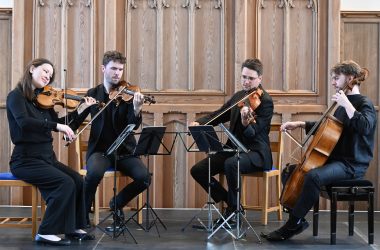Opus 13 show to be the large discovery of the East Neuk Pageant 2024 – Seen and Heard Worldwide

 United Kingdom Varied, East Neuk Pageant 2024 [2]: (SRT)
United Kingdom Varied, East Neuk Pageant 2024 [2]: (SRT)

28.6.2024 – Opus 13 (Sonoko Miriam Welde, Violin Edvard Erdal [violin], Albin Uusijärvi [viola], Daniel Thorell [cello]), Kilrenny Church
Caroline Shaw – Entr’acte
Beethoven – Quartet in B-flat Op.13 with Grosse Fuge
29.06.2024 – Opus 13, Crail Church
Grieg – Quartet in G minor, Op.27
30.6.2024 – Opus 13, Julian Biss (clarinet), Elie Church
Andrea Tarrodi – Madárdal (Quartet No.2)
Mozart – Clarinet Quintet in A, Okay.581
30.6.2024 – Scottish Chamber Orchestra / Maxim Emelyanychev (piano/conductor), Bowhouse, St Monans
Mozart = Piano Concerto No.22 in E-flat, Okay.482
Beethoven – Symphony No.7 in A
Yearly the East Neuk Pageant manages, barely implausibly, to convey a number of the largest hitters in chamber music to a sleepy nook of East Fife that’s tucked away from the remainder of the world. However the pageant additionally showcases newcomers, and one of many nice abilities of the pageant’s director, Svend McEwan-Brown, is to identify rising stars on the best way up and provides them a platform. Therefore on the Friday night of this 12 months’s pageant, the East Neuk’s audiences might hear chamber music royalty and common pageant visitors, the Pavel Haas Quartet and pianist Boris Giltburg taking part in a predictably good programme of Brahms and Tchaikovsky.
Nonetheless, by far the most important discovery of the pageant this 12 months, for me, was Swedish Norwegian string quartet Opus 13, whose a number of concert events made a primary impression that I cannot neglect in a rush. For one factor, they performed with sensationally wealthy tone, supported by the acoustic of the little church in Kilrenny which hosted their first live performance, and which could as effectively have been designed to assist a string quartet. The principle work in that programme was Beethoven’s mighty B-flat Op.130 Quartet, ending with the Grosse Fuge, and Beethoven’s quietly introspective opening lent itself superbly to Opus 13’s richly targeted sound. The gamers leaned into each other in a manner that milked each drop of magnificence from these opening phrases, laying the groundwork for a Cavatina of honeyed heat and calmly flowing religious depth.
What was actually placing about their taking part in of it, although, was how playful a lot of the music sounded. This quartet accommodates so many mysteries and questions whether or not it’s pretty much as good a manner of answering them as any, and the primary Allegro of the primary motion appeared to bounce alongside quite than announce itself from the mountain prime. The entire center actions had a twinkle and a sparkle to them, the sluggish third motion simply as a lot because the spidery second motion and the heel-kicking German dance. The truth is, when you hadn’t been instructed, then you definately would scarcely have realised you have been listening to one of many nice, granite masterpieces of western music.
Till you bought to the final motion, after all. Stravinsky famously described the Grosse Fuge as ‘eternally modern’, however I typically suppose ‘eternally baffling’ may need been a greater quip. In equity to those younger musicians, they refused to let themselves be intimidated by it. As a substitute, they tore with abandon into the opening unisons, and their bows dug into the strains of the fugue in a manner that gave the music actual enamel. The muscular vigour of their taking part in at all times appeared to have one other cease to tug out, however there have been flashes of sweetness too and even, when you knew learn how to pay attention for it, a few of that earlier playfulness.
There wasn’t a lot playfulness to their companion piece, however Caroline Shaw’s tremulously lovely Entr’acte didn’t want it. As a substitute, it appeared to have a deep religious sense that just about shuddered because it was performed. Shaw does so much with slightly, creating tonally interesting music out of just some fragments, not not like the holy minimalism you’ll affiliate with Arvo Pärt, however reimagined for the digital age. So cleverly did Opus 13 form the sound that you could possibly have been tricked into considering that it had been electronically manipulated, regardless that it positively wasn’t: the best way the strains of the central part melted messily into the return of the opening was proof sufficient of that.
On Saturday night Opus 13 carried out Grieg’s accomplished quartet with livewire vitality that appeared to shoot a bolt of lightning by it. The temper of tempestuous vitality characterised even the dark-hued central actions, and didn’t actually carry, even by the ultimate Saltarello. But every now and then they might make the clouds half, most notably in a sensationally beautiful impact on the finish of the primary motion when Daniel Thorell’s cello sang out essentially the most attractive lyrical melody whereas the opposite devices performed a quietly shuddering tremolo. All through, every aching suspension, each lingering concord was invested with unimaginable that means and the sensation that the quartet’s textures have been being illuminated quite than merely pushed.
And on Sunday morning they did a terrific job with Andrea Tarrodi’s Madárdal, a chunk which, like Shaw’s Entr’acte was constructed out of twittering shards of melody repeated, layered, contrasted and melded. The second half of the quartet unfolded its slow-moving music like tendrils of sound by the nonetheless air of Elie Church, sounding utterly hypnotic. Opus 18 have been later joined by clarinettist Julian Biss in a superbly upbeat efficiency of Mozart’s Clarinet Quintet. The quartet supplied light assist for Biss as he gently spun out the attractive lengthy strains of the sluggish motion, whereas the second Trio of the Menuet had all of the swing of a bucolic Ländler. Every participant had their probability to shine individually within the jolly variations of the finale, and everybody appeared like they have been having a whale of a time. Sounded prefer it, too.
If Opus 18 have been my huge discovery of the pageant then the Scottish Chamber Orchestra supplied extra predictable treats. They’re the East Neuk Pageant’s strongest thread of continuity, showing in each one of many pageant’s twenty years, and their programme of Mozart and Beethoven packed out the Bowhouse, an enormous warehouse that serves as a farmer’s market on the primary coastal street. It nearly works as a live performance corridor, although it offers the music an unusually particular sense of location. You by no means really feel that the sound is wherever apart from on the entrance of the corridor: there isn’t a bloom or any sense that the acoustic is carrying the sound to your ear. There’s nothing essentially incorrect with that, although, and it does have the large benefit of readability, one thing that reaped dividends of their tackle Beethoven’s Symphony No.7, which actually let the pure brass and timps let rip.
That’s one thing that conductor Maxim Emelyanychev likes to do, and there are usually sudden treats in retailer when he acts as a concerto soloist, too. These got here by in Mozart’s celebratory PIano Concerto No.22, significantly within the cadenzas, which had a robust really feel of being made up on the spot. If that introduced pleasure to the outer actions then it didn’t convey so many benefits to the sluggish motion, one in all Mozart’s most poignantly heartfelt utterances, which right here felt prefer it was being pulled in a number of instructions without delay. Fluctuations in tempi and even some barely ragged coordination between keyboard and orchestra meant that Mozart’s attractive sense of meditation was interrupted by some clever-clever interpretative touches, which could have labored within the quicker actions, however not a lot right here. Nonetheless, the upbeat jollity of the finale swept all earlier than it, and Emelyanychev even managed to present it area to breathe in its sluggish Menuet-like interlude.
Simon Thompson

